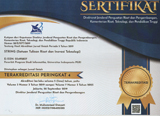Perancangan Basis Data Penjualan dengan Metode Database Lifecycle Pada Toko Lancar Elektrik
(1) Universitas Singaperbangsa Karawang
(2) Universitas Singaperbangsa Karawang
(*) Corresponding Author
Abstract
In this digitalization era, technology is growing rapidly over time. Technological advances have an impact on increasing effectiveness and efficiency in carrying out every job. Toko Lancar Elektrik as one of the stores on Jl. Kertabumi No.8 Karawang Kulon, offers or sells various electrical goods whose number of items increases annually. The problem that exists in Toko Lancar Elektrik is that the collection of the data of item sales and of the stock of goods is still conducted manually using notebooks. The purpose of this study is to use of database technology in selling goods so that the data can be stored quickly and easily and errors in data collection can be minimized. The results of the database design using the DBLC (DataBase Life Cycle) method with research aspects covering Database planning, System definition, Requirements collection and analysis, Database design, to implementation. The database design can have 4 types of entities, namely conceptual, logical, and physical in the form of information on goods, suppliers, orders, and sales. With this database design, it is expected that the goods recording can be more structured and easily to do.
Keywords
Full Text:
PDFReferences
Gat, Perancangan Basis Data Perpustakaan Sekolah dengan Menerapkan Model Data Relasional, CItec J., vol. 2, no. 4, pp. 304315, 2015.
A. D. Hardiansyah, D. C. Nugrahaeni, P. Dewi, and M. Kom, Perancangan Basis Data Sistem Informasi Perwira Tugas Belajar (Sipatubel) Pada Kementerian Pertahanan. 2020.
R. Umar et al., Perancangan Database Point of Sales Apotek Dengan Menerapkan Model Data Relasional, J. Sist. Inf., vol. 03, no. 02, pp. 25795341, 2019.
A. H. Mirza, A. Putra, F. Vokasi, and S. K. Akuntansi, Rancang Bangun Model Perangkat Lunak Informasi Ukm Kota Palembang, J. SIMETRIS, vol. 8, 2017.
S. Taraporevala et al., Microsoft Access 2013 TM An Essential Guide (Level 1)., vol. 23, no. 4. 2017.
M. Razaluddin and E. Evayani, Perancangan Sistem Informasi Persediaan Barang Menggunakan Microsoft Access, J. Ilm. Mhs. Ekon. Akunt., vol. 4, no. 2, pp. 325333, 2019.
T. Oktavia, Perancangan Model Basis Data Sistem Operasional Berbasiskan Customer Relationship Management". Comtech., Vol 4, No 2, 2013.
M. M. Gultom and Maryam, Sistem Informasi Penjualan Material Bangunan Pada Toko Bangunan Berkah, J. Tek. Inform., vol. 1, no. 2, pp. 7986, Dec. 2020.
I. Sutedja, Database Design All in One Theory, Practice, and Case Study. Jakarta: Alex Media Komputindo, 2011.
F. Darnis and R. A. Azdy, Perancangan Basis Data Website Promosi Usaha Kecil Dan Menengah (UKM) Desa Pedado, Kumpul. J. Ilmu Komput., vol. VI, no. 1, pp. 1626, 2019.
E. Mulyatiningsih, Riset Terapan Bidang Pendidikan dan Teknik, p. 183, Yogyakarta: UNY Pers. 2011.
W. S. Prasetya, Perancangan Model Basis Data Relasional Dengan Metode Database Life Cycle, Prosiding Seminar Nasional Informatika. 2015.
DOI: http://dx.doi.org/10.30998/string.v7i2.13933
Refbacks
- There are currently no refbacks.
Copyright (c) 2022 Yusuf Bahtiar, Dene Herwanto

This work is licensed under a Creative Commons Attribution 4.0 International License.
STRING (Satuan Tulisan Riset dan Inovasi Teknologi) indexed by:

Ciptaan disebarluaskan di bawah Lisensi Creative Commons Atribusi 4.0 Internasional.
View My Stats


 Sertifikat Akreditasi
Sertifikat Akreditasi
















